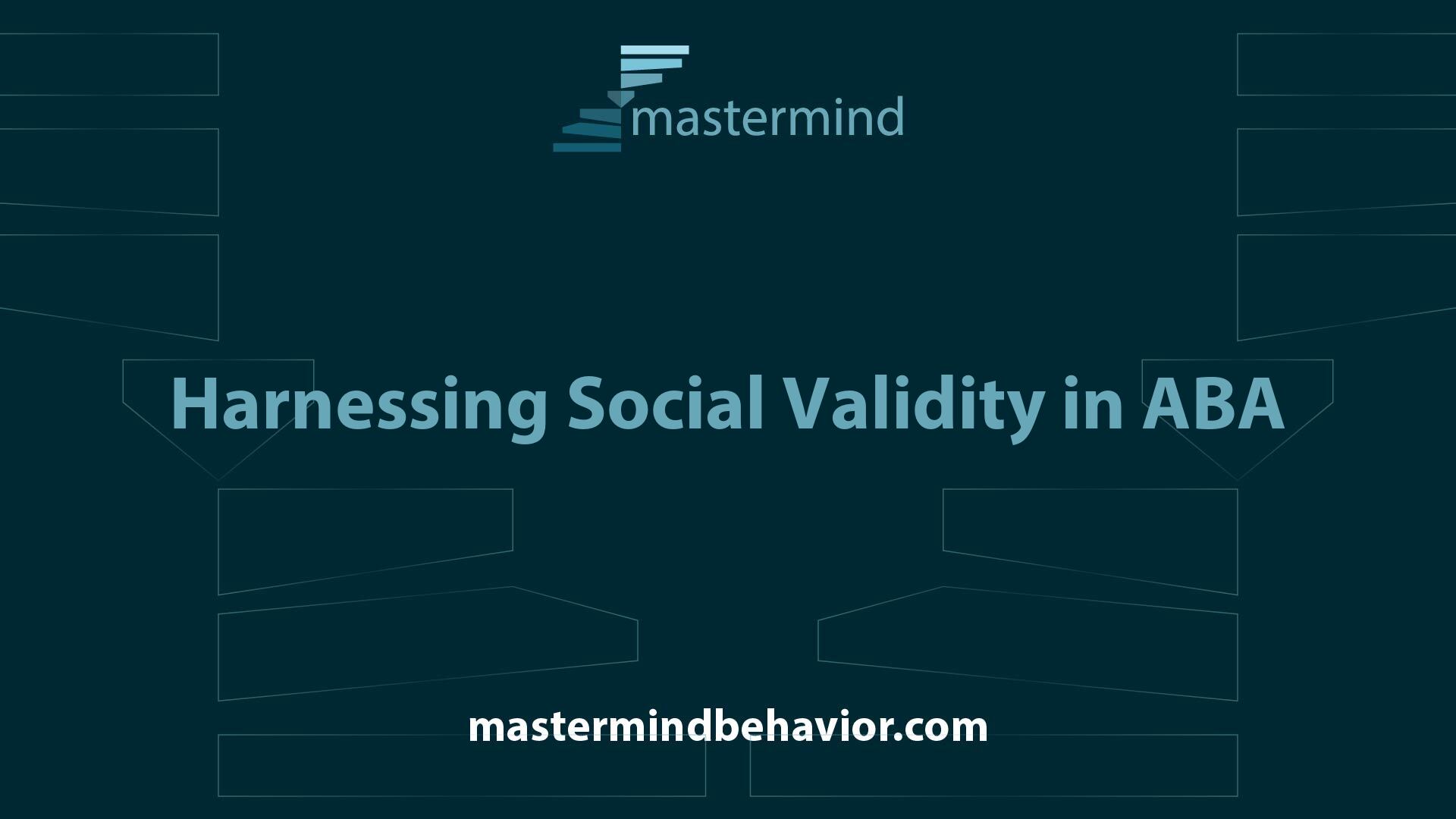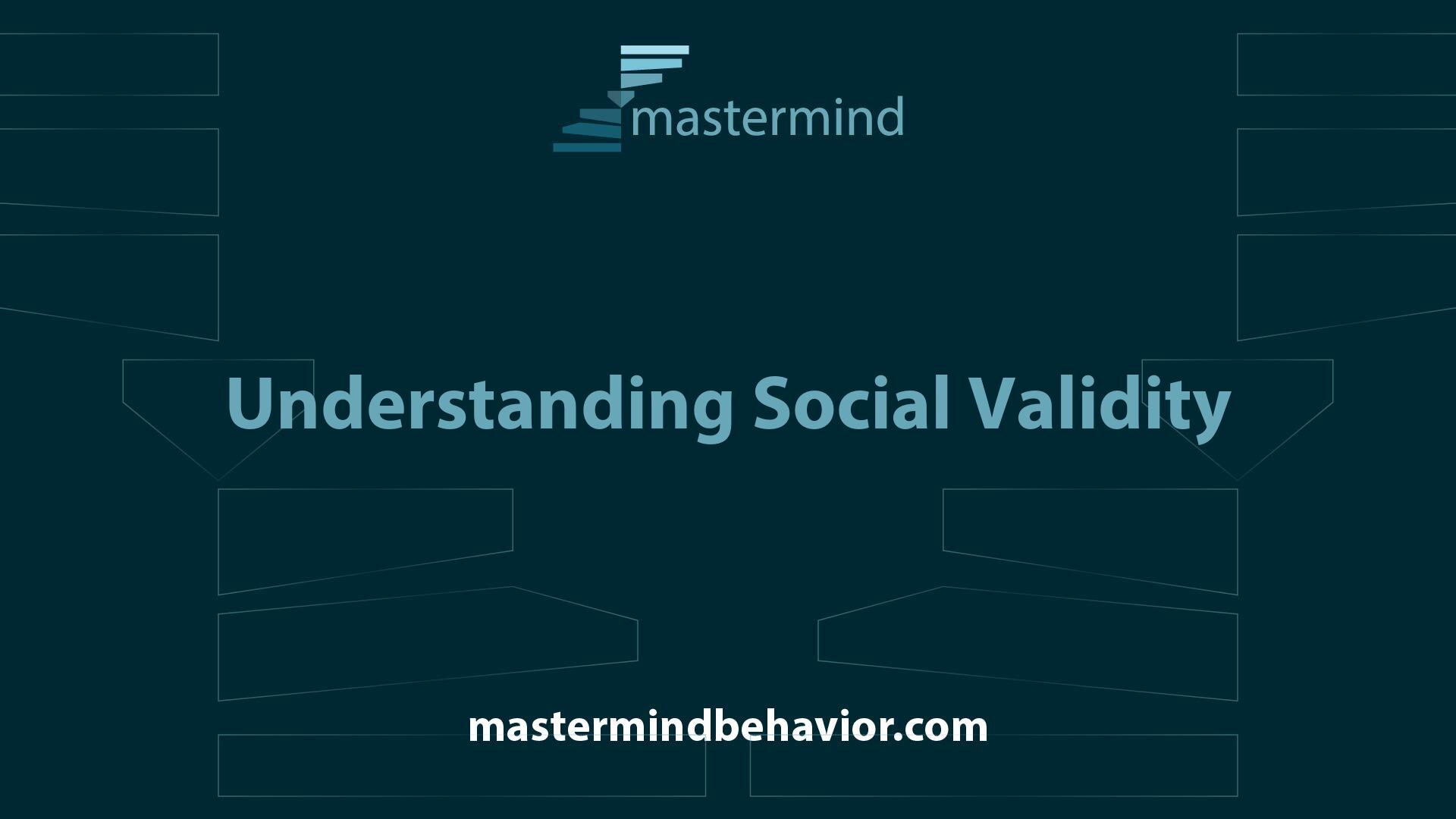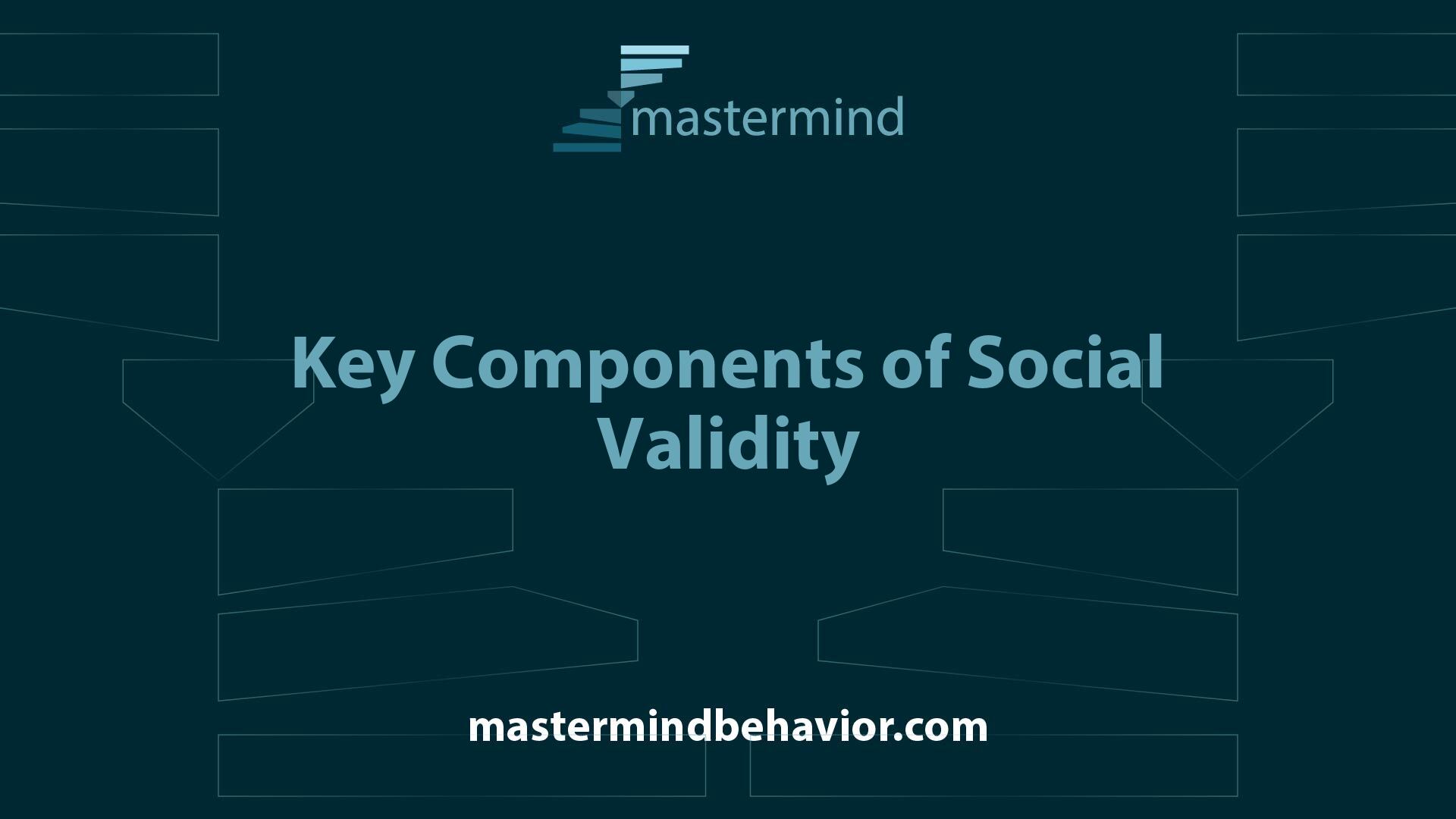Harnessing Social Validity in ABA


Understanding Social Validity
Definition of Social Validity
Social validity in ABA refers to evaluating the extent to which the goals, procedures, and outcomes of an intervention are meaningful and acceptable to the involved individuals, including clients, their families, and other stakeholders. This concept takes into consideration the values, preferences, and priorities of all participants, as well as the broader social context surrounding the intervention [1].
Social validity is viewed as a critical component of ethical practices in ABA. It ensures that interventions not only achieve behavioral change effectively but also foster meaningful improvements in the lives of individuals facing behavioral challenges.
Significance in ABA Practice
The significance of social validity in ABA lies in its ability to ensure that interventions are effective and practical. By assessing the social importance and relevance of the goals and procedures implemented, it emphasizes the perspective of those involved, including clients, families, and other relevant stakeholders.
Understanding social validity helps practitioners tailor interventions that are aligned with the needs and desires of the individuals they support. Assessing social validity ensures that the behavior goals set are not only achievable but also meaningful in the context of a person’s daily life. This approach promotes a more holistic understanding of success in behavior management and improvement, moving beyond mere compliance or skill acquisition to include factors that enrich the lives of individuals involved.
Key AspectsDescriptionGoalsEvaluates the acceptability of behavioral goals based on stakeholder viewpoints.ProceduresConsiders the relevance of methods used in achieving set goals.OutcomesAssesses the meaningful impact of interventions on individuals' lives.
By incorporating social validity into ABA practices, practitioners can enhance the effectiveness of their interventions, creating a more supportive environment that leads to lasting behavioral change.

Key Components of Social Validity
Understanding the key components of social validity is essential for enhancing the effectiveness of Applied Behavior Analysis (ABA) interventions. These components include relevance in interventions, social significance evaluation, and practicality and feasibility.
Relevance in Interventions
Relevance is a crucial aspect of social validity in ABA. It focuses on selecting goals and intervention strategies that are directly related to an individual's needs, strengths, and areas for improvement. By making interventions meaningful and impactful, practitioners can maximize their effectiveness.
ComponentDescriptionRelevanceFocus on individuals' specific needs and strengthsImpactEnsures interventions are meaningfulGoalsAligns with the personal circumstances of the individual
Social Significance Evaluation
Social significance refers to the importance of targeted behaviors or skills in an individual's social environment. This component emphasizes the necessity of teaching skills that enhance social participation, independence, and overall well-being. By focusing on behaviors that create meaningful and lasting changes in the individual's life, the effectiveness of ABA interventions is optimized.
AspectImportanceTargeted BehaviorsSkills that promote social participationIndependenceSkills that enhance self-sufficiencyLife QualityAims for improvements in overall well-being
Practicality and Feasibility
Practicality and feasibility are vital for ensuring that interventions can be successfully implemented in real-world settings. Effective interventions are achievable and can be integrated into daily routines. This component assesses whether the chosen methods can be realistically applied within the individual's context, ensuring that they are both meaningful and achievable.
FactorConsiderationsImplementationHow easily can the intervention be integrated?ResourcesAvailability of necessary tools and supportReal-life ApplicationFeasibility within daily life settings
By addressing these key components—relevance, social significance, and practicality—ABA practitioners can enhance the social validity of their interventions. This creates a framework for effective, meaningful, and socially significant outcomes.
Strategies for Enhancing Social Validity
Social validity is crucial in Applied Behavior Analysis (ABA) as it ensures that interventions are relevant and meaningful. Several strategies can be implemented to enhance social validity, making the interventions more effective and aligned with the needs of those involved.
Stakeholder Collaboration
Collaboration with stakeholders, such as parents, teachers, and caregivers, is essential for enhancing social validity in ABA interventions. This involvement ensures that the intervention plans reflect the perspectives and needs of those impacted by the behavior change. Stakeholder input during the planning stages fosters a sense of ownership and commitment to the intervention's success.
Stakeholder TypeRole in CollaborationParentsAdvocate for their child's needs and preferencesTeachersProvide insights on academic and social contextsCaregiversShare daily routines and environmental factorsProfessionalsOffer expertise in behavioral strategies
Engaging stakeholders in discussions allows for a more comprehensive understanding of the individual’s unique circumstances and promotes effective intervention strategies [1].
Customized Intervention Goals
Individualizing goals and interventions plays a significant role in enhancing social validity. By tailoring objectives to meet the specific needs of individuals receiving services, ABA professionals can create more meaningful interventions. The customization process should involve input from stakeholders, particularly the individuals and families affected by the interventions.
Customized goals ensure that interventions are not only practical but also relevant to the individual's life. For example, if a child has difficulty with social interactions, goals might focus on improving communication skills in settings that matter most to them, such as school or home.
Continuous Assessment
Ongoing assessment and feedback are critical for maintaining social validity in ABA interventions. Regularly evaluating the effectiveness of an intervention allows practitioners to make necessary adjustments. It is essential that the assessment process includes feedback from stakeholders to identify what is working and what needs improvement.
Implementing a structured assessment method can help in gauging the acceptability and feasibility of intervention procedures. Continuous assessment ensures that both the goals and the strategies used remain aligned with the individual’s evolving needs and contexts, promoting generalization and sustainability beyond the therapeutic environment [3].
By applying these strategies—stakeholder collaboration, customized intervention goals, and continuous assessment—ABA professionals can significantly enhance the social validity of their interventions, yielding meaningful outcomes for individuals and their families.
Importance of Social Validity in ABA
Ethical Considerations
Social validity is a critical element of ethical practice in Applied Behavior Analysis (ABA) because it ensures that interventions are effective in facilitating behavioral change while also holding real-world significance. It promotes meaningful improvements in the lives of individuals facing behavioral challenges [1]. Taking into account the values, preferences, and priorities of clients and their families, social validity helps practitioners assess whether the goals of an intervention resonate with those it aims to benefit.
Ethically sound practices in ABA require that interventions not only produce results but also reflect the collective input of stakeholders involved in the process. Evaluating social validity ensures that interventions align with the ethical principles of respect, community, and inclusivity.
Meaningful Behavioral Changes
Meaningful behavioral changes are at the heart of effective ABA practices. Social validity in ABA encompasses assessing the social importance and relevance of the goals and procedures implemented. This assessment ensures that interventions align with the personal and social contexts of individuals involved [2].
AspectDescriptionGoalsEvaluation of whether the goals set in the intervention are significant to the individual and family.ProceduresConsideration of the acceptability and feasibility of the methods used in the intervention.OutcomesAssessment of the real-world effects produced by the behavioral changes.SustainabilityEnsuring that procedures are generalizable beyond the clinical setting for lasting impacts.
Social validity assists in evaluating if interventions are sustainable and can be generalized beyond the therapeutic environment [3]. By focusing on meaningful changes that reflect the perspectives of all stakeholders, ABA practitioners can create more effective and ethically sound interventions that truly enhance the quality of life for those they serve.
Assessment Methods for Social Validity
To effectively gauge social validity in ABA, two primary methods are commonly employed: stakeholder feedback and social impact evaluation. These methods provide valuable insights into the acceptability and relevance of interventions.
Stakeholder Feedback
Gathering feedback from various stakeholders is a crucial aspect of assessing social validity. This process involves collecting input from individuals affected by the intervention, such as clients, their families, teachers, and caregivers. Their perspectives are instrumental in determining whether the goals and procedures of the intervention align with their values, preferences, and priorities [3].
Types of Feedback to Consider:
Type of FeedbackDescriptionSurveysStructured questionnaires that collect quantitative data on acceptability and relevance.InterviewsQualitative discussions that provide deeper insights into stakeholder perspectives.Focus GroupsGroup discussions designed to explore the views of multiple stakeholders on the intervention.
Stakeholder feedback helps ABA professionals make informed decisions and enhances the quality and impact of interventions by ensuring that they are socially acceptable and significant [3].
Social Impact Evaluation
Social impact evaluation focuses on examining the broader effects of an ABA intervention on individuals, families, and communities. This method assesses not only the outcomes of the intervention but also its alignment with social norms and community values.
Key Areas of Social Impact Evaluation:
AreaDescriptionAcceptabilityEvaluating how well the intervention is received among stakeholders.EffectivenessMeasuring the actual changes or improvements observed following the implementation.AppropriatenessDetermining if the goals and methods are suitable given the context and population involved.
This evaluation can be conducted using both quantitative measures, such as statistical analysis of behavioral changes, and qualitative measures that explore subjective experiences of stakeholders [2]. The use of both types of assessments ensures a comprehensive view of social validity in ABA, helping practitioners to refine interventions based on the collective insights of those involved [4].
Trends in Social Validity Assessment
Understanding the evolving landscape of social validity in ABA is crucial for practitioners and researchers. Key trends such as inclusive approaches and terminological consistency gain importance in ensuring assessments and interventions are relevant and effective.
Inclusive Approaches
Inclusive approaches emphasize the involvement of diverse stakeholders in the assessment of social validity. This includes input from individuals receiving interventions, their families, and other relevant parties. Such collaboration ensures that the goals and outcomes of interventions resonate with the needs and preferences of those affected.
Incorporating perspectives from various stakeholders enhances the relevance of the interventions and strengthens the overall effectiveness of behavioral strategies. This inclusivity can lead to better engagement and commitment to the intervention processes, as stakeholders see their input reflected in the practices employed.
Key Benefits of Inclusive Approaches:
BenefitDescriptionEnhanced RelevanceAligns interventions with individual needs and values.Improved EngagementIncreases participation and commitment from stakeholders.Greater SatisfactionEnsures that outcomes are meaningful to those involved.
Terminological Consistency
Terminological consistency plays a vital role in the assessment of social validity. Inconsistent use of terms across various journals leads to confusion and misunderstanding within the behavior analytic community. The review highlighted that clear and consistent terminology regarding social validity assessments is essential for clarity and understanding in behavior analytic literature.
Despite "social validity" being a commonly used term, variations exist across journals where some may use alternate terms more frequently. Not all journals reported social validity assessments consistently, which undermines the reliability of findings in the field.
Adopting standardized terminology can streamline communication, enhance collaboration, and improve the overall comprehension of social validity assessments within ABA. This consistency not only aids researchers but also practitioners implementing the strategies informed by clear definitions and expectations.
Impact of Terminological Consistency:
EffectDescriptionImproved ClarityReduces confusion regarding assessment methods and outcomes.Enhanced CollaborationFosters better communication among researchers and practitioners.Increased TrustBuilds confidence in findings and methodologies used in the field.
By focusing on these trends, the field of ABA can foster more effective, meaningful interventions that align with the goals and lives of individuals facing behavioral challenges.
References
[2]:
[3]:
[4]:
Recent articles

How to Support Peer Relationships for Children with Autism
Building Bridges: Fostering Peer Connections in Children with Autism

The Benefits of Community-Based ABA Therapy for Social Skills Development
Fostering Social Integration and Independence in Children with Autism

How ABA Therapy Helps Build Daily Living Skills in Children
Empowering Independence: The Transformative Role of ABA in Children's Daily Skills

The Role of Collaborative Goal Setting in ABA Therapy Programs
Enhancing Outcomes Through Teamwork in ABA Therapy

How In-Home ABA Therapy Encourages a Natural Learning Environment
Creating Comfort and Confidence in Home-Based Autism Support

Understanding the Impact of Co-Occurring Conditions on Autism Treatment
Navigating Complexities: How Co-Occurring Conditions Shape Autism Interventions


